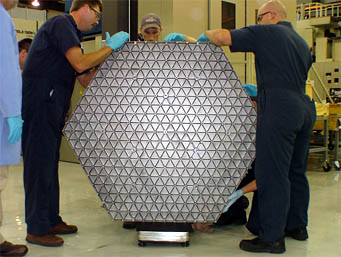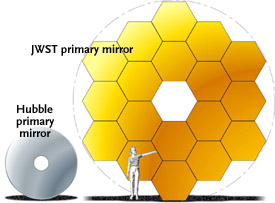Against a backdrop of the worst financial crisis since the 1930s, no one quite knows what will happen to NASA's future plans once Barack Obama becomes president. Will Michael Griffin remain the agency's chief? Will plans to return astronauts to the Moon be scrapped? Will space exploration in general — viewed by some as frivolous waste and by others as a ray of accomplishment amid all the bleakness — be slashed to a bare minimum?
We'll know soon enough. In the meantime, NASA continues to work toward assembling and launching the eventual replacement for the Hubble Space Telescope, currently the crown jewel of its astronomy program.

Technicians gingerly handle the honeycombed beryllium mirror segment that will eventually join 17 others to form the primary mirror of the James Webb Space Telescope.
Axsys
The James Webb Space Telescope could be launched as early as June 2013 aboard a European-built Ariane rocket, though I'm not locking in airline reservations to French Guiana just yet.
Progress is slowly being made on the $4.5 billion project. This week the first of JWST's 18 mirror segments arrived at NASA's Marshall Space Flight Center in Huntsville, Alabama. The honeycombed beryllium hexagon will soon be tested in a space-simulating chamber to make sure it can hold up to the extreme cold it'll encounter in space.
If the spacecraft works as planned, a sunshield will keep the telescope's optics (and the entire observatory, in fact) permanently in shadow so that its temperature can constantly hover near 40 kelvin (-388°F). Such a frigid extreme is necessary to allow JWST to probe the universe at deep infrared wavelengths between 0.6 and 28 microns, to capture the dim glow of distant collections of barely warm gas and dust.

Measuring more than 21 feet (6.5 m) across, the primary mirror for the James Webb Space Telescope will have a diameter some 2½ times that of the Hubble Space Telescope.
NASA
According to yesterday's press release, the testing of the JWST mirror segments will continue until 2011. Each hexagon-shape segment measures 4.9 feet (1.5 m) corner to corner, and together they'll create a collecting surface 21 feet (6.5 m) across. The Hubble Space Telescope's primary mirror, by comparison, has a diameter of 94 inches (2.4 m).
Right now this giant space observatory is about halfway from 2002, when it was named after a former NASA administrator, until its scheduled launch. Let's hope the project has smooth sailing from here on out.
 1
1
Comments
mike fallwell
December 12, 2008 at 4:10 pm
How was it made? designed? detectors?
You must be logged in to post a comment.
You must be logged in to post a comment.